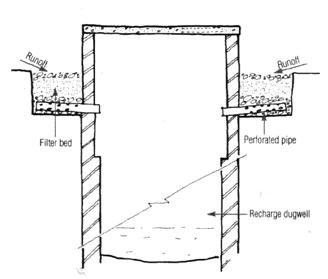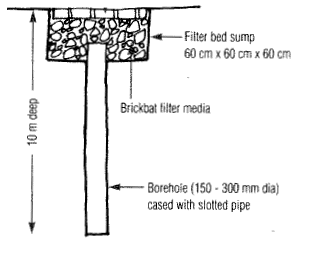 Where conditions are favorable, it is better to recharge the groundwater than to create surface ponds for storage. This approach minimizes evaporative losses, and often improves water quality. Recharge structures can be anything from a small pit simply dug into the soil, to a borewell converted for recharge. Recharge structures are useful in sloping landscapes where the water would not otherwise have time to sink into the ground before running off. The structures should be located in relatively low areas, so the water will naturally flow into them. Another good location is behind a check dam, so that the water is slowed and has time to infiltrate.
Where conditions are favorable, it is better to recharge the groundwater than to create surface ponds for storage. This approach minimizes evaporative losses, and often improves water quality. Recharge structures can be anything from a small pit simply dug into the soil, to a borewell converted for recharge. Recharge structures are useful in sloping landscapes where the water would not otherwise have time to sink into the ground before running off. The structures should be located in relatively low areas, so the water will naturally flow into them. Another good location is behind a check dam, so that the water is slowed and has time to infiltrate. Soil permeability may be greater at greater depths, so there may be some advantage in digging a deeper recharge structure. If the aquifer one is intending to recharge is deep and there is any kind of confining layer over the aquifer, then the recharge structure itself must be deeper. One trick for increasing the depth of recharge is called a soakaway. It is a simple pit, perhaps 0.6m cubed, with a small diameter borehole going down to 10 meters. In sandy soil the borehole should be lined with perforated piping so that the walls do not collapse, but in clay soil this is not necessary.
Soil permeability may be greater at greater depths, so there may be some advantage in digging a deeper recharge structure. If the aquifer one is intending to recharge is deep and there is any kind of confining layer over the aquifer, then the recharge structure itself must be deeper. One trick for increasing the depth of recharge is called a soakaway. It is a simple pit, perhaps 0.6m cubed, with a small diameter borehole going down to 10 meters. In sandy soil the borehole should be lined with perforated piping so that the walls do not collapse, but in clay soil this is not necessary.
Great care should be taken to keep silt and debris from entering the recharge structure, otherwise it will block the infiltration of the water. This can be done by creating smaller pits to allow the silt to settle before the water enters the true recharge structure. For an example, see the picture where a dug well has been surrounded by a pit filled with pebbles or broken brick and sand, with perforated pipes at the bottom leading into the well itself. This filters the water before it enters the recharge structure. It is much easier to clean these small filtration pits than to clean the bottom of the well itself.
/articles/groundwater-recharge-structures